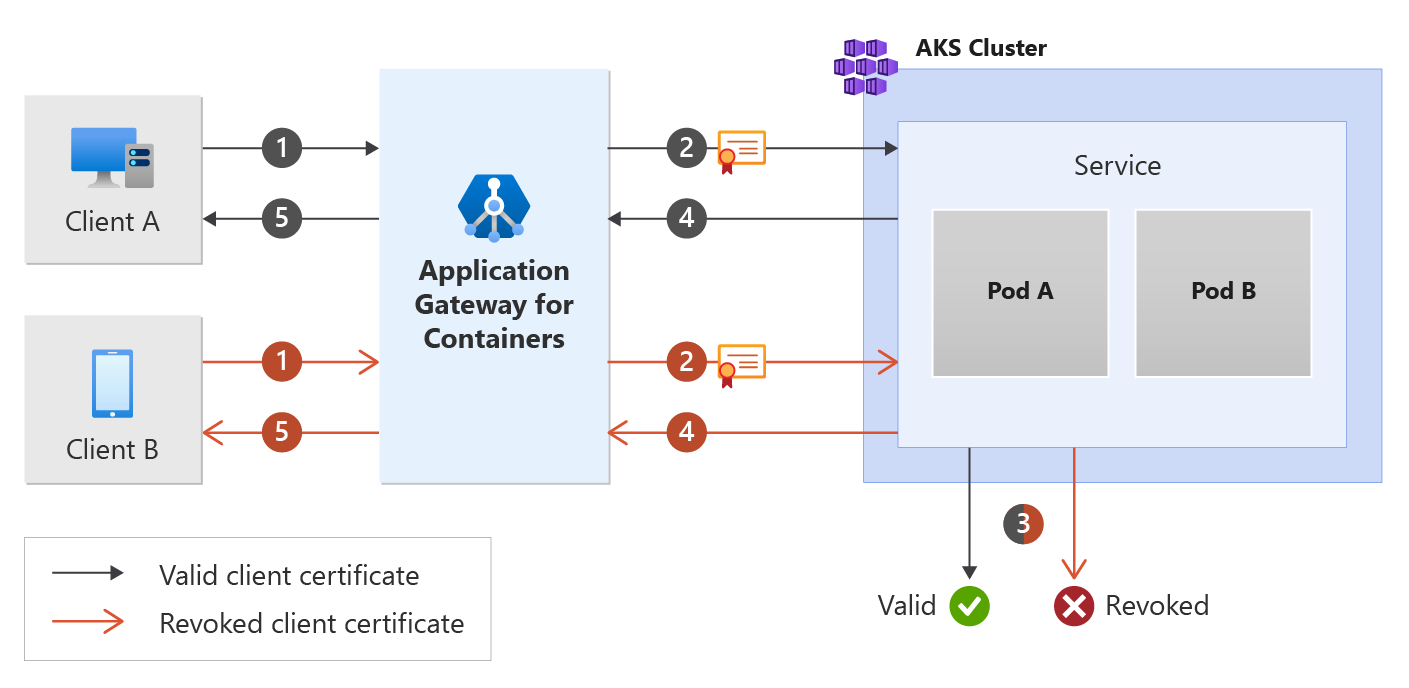Container の Application Gateway を使ったバックエンド MTLS - ゲートウェイ API
このドキュメントは、Gateway API から次のリソースを使用するアプリケーションの例を設定するのに役立ちます。 以下を行うための手順を示します。
- HTTPS リスナーを 1 つ持つ Gateway リソースを作成します。
- バックエンド サービスを参照する HTTPRoute リソースを作成します。
- HTTPRoute で参照されるバックエンド サービスのクライアントと CA 証明書を持つ BackendTLSPolicy リソースを作成します。
背景
相互トランスポート層セキュリティ (MTLS) は、通信を暗号化し、サービスに対するクライアントを識別するために証明書に依存するプロセスです。 これにより、バックエンドのワークロードは、認証済みデバイスからの接続のみを信頼することで、セキュリティ体制を向上させることができます。
次の図を参照してください。
前提条件
BYO デプロイ戦略に従う場合は、Application Gateway for Containers リソースと ALB コントローラーを設定していることを確認します。
ALB マネージド デプロイ戦略に従う場合は、ALB コントローラーのプロビジョニングと、ApplicationLoadBalancer カスタム リソースを介した Application Gateway for Containers リソースのプロビジョニングが完了していることを確認します。
サンプル HTTP アプリケーションをデプロイします。
クラスターに次の deployment.yaml ファイルを適用し、サンプル Web アプリケーションを作成してバックエンド相互認証 (mTLS) のデモンストレーションを行うためのサンプル シークレットをデプロイします。
kubectl apply -f https://raw.githubusercontent.com/MicrosoftDocs/azure-docs/refs/heads/main/articles/application-gateway/for-containers/examples/https-scenario/end-to-end-ssl-with-backend-mtls/deployment.yamlこのコマンドによって、クラスターに次のものが作成されます。
test-infraという名前空間test-infra名前空間内のmtls-appという 1 つのサービスtest-infra名前空間内のmtls-appという 1 つのデプロイtest-infra名前空間内のmtls-app-nginx-cmという 1 つの構成マップtest-infra名前空間内のbackend.com、frontend.com、gateway-client-cert、ca.bundleという 4 つのシークレット
必要な Gateway API リソースをデプロイする
ゲートウェイを作成する
kubectl apply -f - <<EOF
apiVersion: gateway.networking.k8s.io/v1
kind: Gateway
metadata:
name: gateway-01
namespace: test-infra
annotations:
alb.networking.azure.io/alb-namespace: alb-test-infra
alb.networking.azure.io/alb-name: alb-test
spec:
gatewayClassName: azure-alb-external
listeners:
- name: https-listener
port: 443
protocol: HTTPS
allowedRoutes:
namespaces:
from: Same
tls:
mode: Terminate
certificateRefs:
- kind : Secret
group: ""
name: frontend.com
EOF
Note
ALB コントローラーは、ARM で Application Gateway for Containers リソースを作成するときに、フロントエンド リソースに対して次の名前付け規則を使用します。fe-<ランダムに生成された 8 文字>
Azure で作成されたフロントエンドの名前を変更したい場合は、BYO デプロイ戦略に従うことを検討してください。
ゲートウェイ リソースが作成されたら、状態が有効であること、リスナーが [プログラム済み] であること、ゲートウェイにアドレスが割り当てられていることを確認します。
kubectl get gateway gateway-01 -n test-infra -o yaml
ゲートウェイの作成に成功した出力例。
status:
addresses:
- type: IPAddress
value: xxxx.yyyy.alb.azure.com
conditions:
- lastTransitionTime: "2023-06-19T21:04:55Z"
message: Valid Gateway
observedGeneration: 1
reason: Accepted
status: "True"
type: Accepted
- lastTransitionTime: "2023-06-19T21:04:55Z"
message: Application Gateway For Containers resource has been successfully updated.
observedGeneration: 1
reason: Programmed
status: "True"
type: Programmed
listeners:
- attachedRoutes: 0
conditions:
- lastTransitionTime: "2023-06-19T21:04:55Z"
message: ""
observedGeneration: 1
reason: ResolvedRefs
status: "True"
type: ResolvedRefs
- lastTransitionTime: "2023-06-19T21:04:55Z"
message: Listener is accepted
observedGeneration: 1
reason: Accepted
status: "True"
type: Accepted
- lastTransitionTime: "2023-06-19T21:04:55Z"
message: Application Gateway For Containers resource has been successfully updated.
observedGeneration: 1
reason: Programmed
status: "True"
type: Programmed
name: https-listener
supportedKinds:
- group: gateway.networking.k8s.io
kind: HTTPRoute
ゲートウェイが作成されたら、HTTPRoute リソースを作成します。
kubectl apply -f - <<EOF
apiVersion: gateway.networking.k8s.io/v1
kind: HTTPRoute
metadata:
name: https-route
namespace: test-infra
spec:
parentRefs:
- name: gateway-01
rules:
- backendRefs:
- name: mtls-app
port: 443
EOF
HTTPRoute リソースが作成されたら、ルートが [承認済み] になり、Application Gateway for Containers リソースが [プログラム済み] になっていることを確認します。
kubectl get httproute https-route -n test-infra -o yaml
Application Gateway for Containers リソースの状態が正常に更新されたことを確認します。
status:
parents:
- conditions:
- lastTransitionTime: "2023-06-19T22:18:23Z"
message: ""
observedGeneration: 1
reason: ResolvedRefs
status: "True"
type: ResolvedRefs
- lastTransitionTime: "2023-06-19T22:18:23Z"
message: Route is Accepted
observedGeneration: 1
reason: Accepted
status: "True"
type: Accepted
- lastTransitionTime: "2023-06-19T22:18:23Z"
message: Application Gateway For Containers resource has been successfully updated.
observedGeneration: 1
reason: Programmed
status: "True"
type: Programmed
controllerName: alb.networking.azure.io/alb-controller
parentRef:
group: gateway.networking.k8s.io
kind: Gateway
name: gateway-01
namespace: test-infra
BackendTLSPolicy の作成
kubectl apply -f - <<EOF
apiVersion: alb.networking.azure.io/v1
kind: BackendTLSPolicy
metadata:
name: mtls-app-tls-policy
namespace: test-infra
spec:
targetRef:
group: ""
kind: Service
name: mtls-app
namespace: test-infra
default:
sni: backend.com
ports:
- port: 443
clientCertificateRef:
name: gateway-client-cert
group: ""
kind: Secret
verify:
caCertificateRef:
name: ca.bundle
group: ""
kind: Secret
subjectAltName: backend.com
EOF
BackendTLSPolicy オブジェクトが作成されたら、オブジェクトの状態を確認し、ポリシーが有効であることを確認します。
kubectl get backendtlspolicy -n test-infra mtls-app-tls-policy -o yaml
有効な BackendTLSPolicy オブジェクト作成の出力例。
status:
conditions:
- lastTransitionTime: "2023-06-29T16:54:42Z"
message: Valid BackendTLSPolicy
observedGeneration: 1
reason: Accepted
status: "True"
type: Accepted
アプリケーションへのアクセスをテストする
これで、フロントエンドに割り当てられた FQDN を使用して、サンプル アプリケーションにトラフィックを送信する準備ができました。 次のコマンドを実行して、FQDN を取得します。
fqdn=$(kubectl get gateway gateway-01 -n test-infra -o jsonpath='{.status.addresses[0].value}')
この FQDN に curl を実行すると、HTTPRoute で構成されているバックエンドから応答が返されます。
curl --insecure https://$fqdn/
これで、ALB コントローラーをインストールし、バックエンド アプリケーションをデプロイして、Application Gateway for Containers のイングレス経由でアプリケーションにトラフィックをルーティングすることができました。
